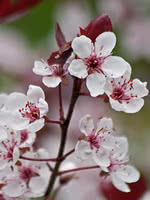Mon-Fri 9am - 5pm Mountain time
Echinacea vs Purple Leaf Sand Cherry
Echinacea angustifolia
Prunus x cistena
ONLY AVAILABLE BY CONTRACT GROW
ONLY AVAILABLE BY CONTRACT GROW
Echinacea is a unique flowering plant that has been used by Native Americans as medicine for centuries.
Tall stalks topped with badminton-birdie-like flowers make this plant a distinctive addition to any garden or yard.
Echinacea this drought tolerant and will attract bees, butterflies, birds and other wildlife.
Purple Leaf Sand Cherry provides bright reddish-purple leaves that turn bronze-green in the fall. In the spring, tiny flowers with a pinkish white hue bloom. The flowers are small, but the impact comes from the shrub blossoming all at once.
The Purple leaf sand cherry can be susceptible to pests and diseases in more humid areas; a typical life span is approximately 15 years. Not suitable for a privacy hedge on its own but is often alternated with lilacs. Often used as an accent plant that attracts birds and bees.
Echinacea Quick Facts
Purple Leaf Sand Cherry Quick Facts
Toxicity: the leaves and seed are slightly toxic

